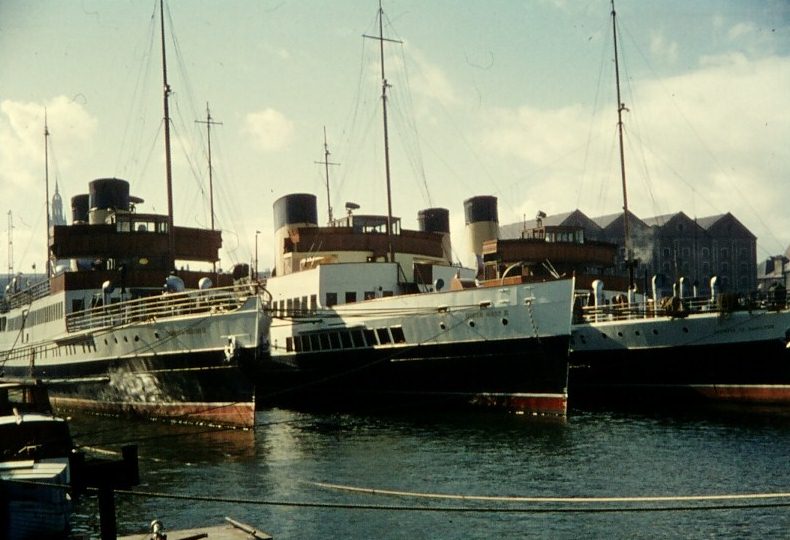
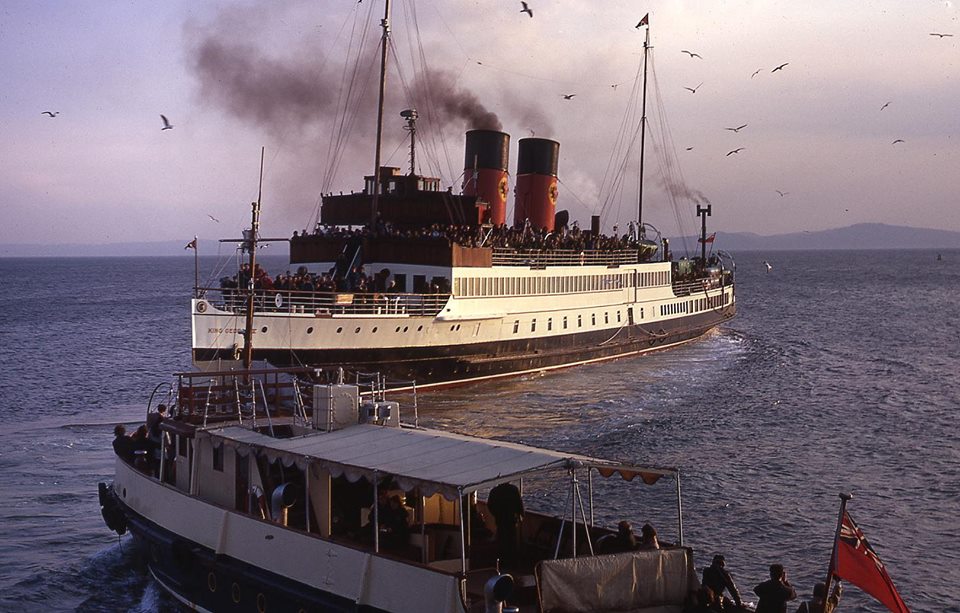
Compare the three Turbine Steamers
Whilst steam turbine power came
to dominate deep-sea and short-sea (eg cross-channel ferries, and services from
the U.K. to Ireland,
the Isle of Man etc) for a short time in the first half of the twentieth century, its
adoption for coastal, estuarine and lake vessels was more limited. For vessels
in these waters, paddle
propulsion, which had quickly become obsolete for deep-sea shipping, and the
necessary reciprocating engines, remained significant until World War II. After this time,
motor vessels came to dominate in the UK, as they had already begun to in mainland
Europe.
Turbine steamers were never adopted in
European inland operations, and on Swiss lakes, the largest group of
excursion vessels, the marine diesel motor was adopted as early as the late
1920s.
The Firth of Clyde becomes the main area to
adopt Steam Turbine Propulsion in coastal passenger service
The U.K., adopted
home of Charles Parsons, investor and developer
of the modern steam turbine, became
the main test-bed for turbines in coastal steamers but even in most areas
where large fleets of paddlers existed, turbine steamers failed to make
inroads. The one exception was the Firth of Clyde, where T.S. King Edward
became the first excursion steamer to feature turbines when it entered
service in 1901. A syndicate of investors headed by Captain John Williamson,
from a family of famous steamboat captains on the Clyde,
and including forward-looking shipbuilders (Wm. Denny & Co of Dumbarton) and promoting
engineer (Parsons Marine
Steam Turbine Co Ltd), set up a new company to operate the experimental vessel which proved
so successful that a consort, Queen Alexandra, was delivered for the
following season.
The main existing operators on the Clyde also examined the
option of a turbine steamer : the Caledonian Steam Packet Company took
delivery of the highly-successful Duchess of Argyll in 1906 and the Glasgow
and South Western Railway ordered the rather less successful Atalanta for
1906.
These vessels were much more expensive than the paddle steamers
which were still being built – partly due to their size and well-appointed
facilities, but also due to the high initial cost of the machinery. However,
they had an enormous advantage in speed, with 20 knots easily achievable in
open waters, and significantly improved fuel economy. This made them highly attractive for full-day excursions and it
was these vessels which were normally to be seen at the more
remote destinations on the Firth, with Campbeltown and Inveraray almost
always served by a turbine steamer. In the case of Atalanta, the ship was allocated
to the long ferry crossing from Ardrossan to Arran where she spent most
of her life because the Glasgow & South
Western did not have the appropriate regulatory permission to visit the
more far-flung piers on the Firth. On the longer runs, more exposed waters were
encountered, making these screw-driven turbine steamers even more advantagous
than a paddle steamer. The main benefit of the screw over the paddle in anything
but smooth waters was that due to their full immersion in the water at all times,
their efficiency was not affected by the constant variability of the water level
at the paddles which meant that the paddle rarely achieved the optimum propulsive
effect from the power employed.
Another advantage of the turbine was the extremely
smooth operation, with the characteristic surges experienced on the
paddle steamers of the time completely eliminated. This smooth and
quiet operation was also
to be a major advantage for turbine steamers in comparison with
their later competitor, the motor vessels - and it was also a significant
factor in the turbine's widespread application in military vessels where stealth
and speed were of utmost importance.
The success of this new type of vessel did not lead to the
total abandonment of paddle propulsuion for new ships on the Clyde. The existing operators’ main business was
providing passenger connections between their coastal railway termini and the
various villages on the opposite side of the Firth. This required rapid
manoeuvring from and into a number of piers in quick succession – and
paddlers were seen as more suitable for this work, both in terms of economy
of operation but also manoeuvrability. The shallowness of the upper Clyde estuary,
particularly at Craigendoran, the railhead of the LN&ER railway required
vessels with a shallow draught - and for this reason, turbine steamers were
very rare visitors to this pier right up until its closure in the 1970s.
The timing was not right either. It
followed closely after a period of ruinous competition between the steamer
companies who were left short of money and with more vessels than demand
could justify. Vessels were laid-up and agreements between operators to
share routes was a forerunner of later amalgamations. Few new vessels were
built before a renaissance in some of the fleets in the 1930s. Turbine
Steamers Ltd replaced their fire-damaged Queen Alexandra with a new,
but substantially similar ship of the same name in 1912 and the Caledonian
Steam Packet Company bought a new “Glen Sannox” in 1925 to replace an
older paddle steamer of the same name, whose excessive coal consumption
had become a major problem for the company for their Ardrossan to Arran run. The new Glen Sannox made
the accountants happier, but she was similar to the Queen Alexandra in
most respects and was outdated immediately after her arrival.
This was
because Turbine Steamers Ltd introduced a vessel in 1926 which incorporated
numerous improvements. She was a far more luxuriously appointed vessel, with
most of the promenade deck enclosed in one large saloon extending the full
width of the vessel and for much of its length, but also had new and
experimental features in the engine room below deck. Her high pressure boiler and
complicated turbine arrangement allowing for
quadruple expansion of the steam. It was to prove problematic but once this problem was
overcome after a second boiler change and the removal of one turbine in 1935, she was to be
the template for new turbine steamers which were to be the ultimate in luxury
for Clyde cruising.
The 1930s saw a recovery in
demand for excursions although the economic problems of the 1920s exacerbated
by the “Wall Street Crash” persisted andleft large numbers of the population
in a perilous financial position. With shipyards desperate for work, new
ships could be bought relatively cheaply and the Caledonian Steam Packet
Company took the design of King George V as the basis for two new steamers,
Duchess of Montrose (1930-1964) and Duchess of Hamilton (1932-1970). These
were to become two of the most-loved vessels ever to sail on the
Clyde.
Williamson-Buchanan Ltd, the company formed out of the fleets of
Captain John Williamson, the driving force behind Turbine Steamers Ltd, and
that of Captain William Buchanan also speculated to capitalise on the
possible upturn in business. Queen Mary, delivered in 1933, was to be the
most luxurious Clyde steamer to date, providing the last word in facilities
for “all-the-way” cruises from Glasgow, a route on which the ships employed
had hitherto been less than salubrious.
The Caledonian did introduce a
new turbine, the Marchioness of Graham in 1936 and by three years Queen Mary's
junior, but she was designed as a
ferry for the Arran service, with deck space available for cargo at the
expense of passenger facilities. She was a “workhorse” for year-round service
on one of the Clyde’s most exposed crossings.
The Second World War
brought an end this period of new building, and when new vessels were
next added to the fleet, they were, for clear financial reasons, to be
diesel powered.
The turbine steamers survived the war unscathed. Unlike
their paddler fleet-mates, they were not requisitioned by the Admiralty
for minesweeping duties on account of their deeper draught and were
less exposed to the dangers of war. Queen Mary even remained on the
Clyde in a passenger role, painted grey, maintaining the connections
from the coast to Dunoon.
The new vessels, seven of which
arrived in 1953/54, signalled the replacement of older vessels,
amongst them the pioneering King Edward, Queen Alexandra (which had
sailed for David MacBrayne as St Columba since 1935), Duchess of
Argyll, Glen Sannox and even the relatively modern Marchioness of
Graham.
By the 1960s, the Caledonian Steam Packet Company operated three
large turbines, the Duchesses of Montrose and Hamilton, plus Queen
Mary (which had come under Caledonian control in 1935). Spending most
of its time in Oban and the Western Isles was King George V, which
had transferred to David MacBrayne along with Queen Alexandra when
the Turbine Steamers operation was wound up in 1935.

Above : Three Clyde Turbine Steamers : Duchess of Montrose,
Queen Mary II and Duchess of Hamilton await another season
at their winter lay-up berth at Greenock in the early 1960s. The
Clyde was the "home" of turbine excursion vessels.
Photo
by Alexander Bain, kindly contributed by Donald Bain
By 1973
when the Caledonian and MacBrayne operations had been merged into a new
organisation charged with developing highly efficient ferry services in
the west of Scotland, only Queen Mary and King George V remained. By
the end of 1977, the era of the turbine steamers was over.
It
had been no surprise that Caledonian-MacBrayne, who had been unable to
operate their remaining turbines without large subsidies,
withdrew the last two vessels, but it was perhaps more of a surprise
that turbines had not been so successful elsewhere around the British
coastline. The other main areas where large fleets were in service were
the Thames Estuary, the Bristol Channel and on the south coast
around the
Solent.
Turbine Steamers in Coastal Cruising Elsewhere in Britain
It was on the Thames, where large paddle steamers were employed
ferrying Londoners out to the Kent and Essex resorts where a turbine steamer
was put into operation. In 1906, the General Steam navigation company took
delivery of the Kingfisher, a vessel not dissimilar to her Clyde
contemporaries except that she had only one funnel. The difference was that
her prime role was to be on the cross-channel routes which were increasingly
popular for long day trips. Passengers could leave the Thames piers for a few
hours ashore in France or even in Ostend, Belgium and be home within the
day.
Kingfisher was employed on services to Boulogne from Tilbury so
was effectively on short-sea work rather than coastal cruising. Even in
this role she was not a success, being found hard to handle at piers and she
was sold to Italian owners in 1912. When the GSN did decide to buy a new
screw steamer, the Queen of the Channel, built by Denny of Dumbarton, was a
motor powered ship. The New Medway Steam Packet Company also switched to
motor vessels with the Royal Sovereign of 1937. Both these ships were
employed on cross-channel sailings. The two companies merged at this time and
added an even bigger motor vessel, the 2060 tonnes Royal Daffodil.
On
the Bristol Channel, where the P & A Campbell company reigned
supreme there was no attempt to introduce turbine steamers, but the company
did traditionally operate a summer service on the South Coast of England.
They too eyed up cross-channel services and decided to order a 1200
tonne turbine steamer - to be called Empress Queen. As fate would have it,
she was not ready until 1940 by which time World War II had begun and she
was immediately requisitioned by the Admiralty for troop transport
duties between Stranraer and Larne. When she returned to her owner, the
Campbells were unable to use her on her intended route. Currency restrictions
and the ending of "no-passport" trips to the continent meant that a new use
had to be found for her. As she was not suitable for operation in the
upper reaches of the Channel, she was put on the Swansea - Ilfracombe
crossing but even on this route she was hard to handle and after numerous
minor bumps at piers, her first season was cut short early. She was sent to
the south coast for the next three seasons, but was equally unsuccessful.
She was also dogged by mechanical trouble and was clearly too large for
the services undertaken. In 1951 she was transferred to the
south-west, operating out of Torquay to the Channel Islands and also offering
local coastal cruises. On the long runs she was rarely anything above half
full, on the local cruises she ran almost empty. Faced with such
problems, Campbells laid her up after the 1951 season and sold her to Greek
owners for a knock-down price in early 1955. The Greeks converted her to a
cruise ship with full accommodation for week and two-week cruises and
converted her to diesel operation. Ironically, government restrictions
on cross-channel sailings eased later in the same year, but it is clear
that the Campbells only wanted to get the costly vessel off their
hands. The three main operators in the South Coast and Solent area, the
railway company providing connections to the Isle of Wight from their
mainland railheads, the private company servicing the Island from
Southampton and the Cosens Company based nearby at Weymouth, remained loyal
to paddle steamers - until the motor vessel era. The Southampton company
introduced the motor vessel Medina on its Southampton-Cowes ferry service in
1931 and added the Vecta, a motor vessel with Voith-Schneider propulsion, in
1939. The same company also introduced the twin-screw motor vessel
Balmoral, which operates today as part of the Waverley operation, in 1949. At
this time, the railway company, now part of British Railways operating
primarily out of Portsmouth and serving Ryde on the Isle of Wight, weighed up
whether its new vessels would be paddlers or motor vessels,. The decision
fell in favour of the latter.
Therefore, turbine steamers only found
successful employment in areas traditionally served by paddlers on the Clyde
- but with one important exception. The Liverpool and North Wales
Steamship Company was established in 1891 after the amalgamation of several
local operators to provide services out of the major city of Liverpool to the
North Wales coast, a popular destination for excursions and longer holidays.
Excursions around the Isle of Anglesey wee offered as well as "short-sea"
crossings to the Isle of Man. This company ordered its first turbine steamer
St Seiriol in 1914. The ship was immediately requisitioned for wartime
service and was sunk off Harwich in 1918 before she could be used in her
intended role. It was not until 1926 that the company was able to make the
substantial investment in a brand new turbine steamer. St Tudno, with a gross
tonnage of 2300 and a passenger capacity of approaching 2500 was a large
vessel, but successful in her business, so much so that a slightly smaller
turbine steamer St Seiriol (1586 tonnes) joined her in the fleet. Both
vessels survived until the company went into liquidation in 1962, St Tudno
laid-up for that year, and St Seiriol sailing alongside the much smaller
motor vessel St Trillo which had been bought prior to World War
II.
The demise of the Liverpool company echoed general economic trends in
the 1960s which impacted on excursion vessel fleets all around the country.
By the end of the 1964 season the Caledonian Steam Packet Company had, to
some people's great surprise, withdrawn their hugely successful turbine
Duchess of Montrose at the age of only 34. Motor power was no saviour either.
At the end of 1966, the General Steam Navigation Company announced the
ending of its services from London. Royal Daffodil went quickly to the
breakers. The two other vessels, both post-war replacements for lost namesakes
Queen of the Channel and Royal Sovereign did find new employment, one in Greece, the
other converted to a car transporter.
The failed story of turbine
steamers in British coastal cruising makes their success on the Clyde all the
more unique. Turbine technology was applied to vessels only slightly larger
than their paddler consorts and the largest example, Queen Mary, was
substantially smaller than Queen Empress, St Tudno or St Seiriol. They were
found not to be too hard to handle on the Clyde, although it is to be
recognised that the waters in the Firth are more sheltered than elsewhere on
the coast, and held pride of place in the fleet from 1901 to 1977.
TS MANXMAN : THE LAST SHORT SEA TURBINE STEAMER (1955-1982) SURVIVED UNTIL 2012
As noted above, turbine steamers came to dominate short sea ferry crossings, such as the English Channel, but also services from the UK mainland to the Isle of Man, a Crown dependency in the Irish Sea, roughly equidistant from Scotland, England and Ireland. The last of her class was SS Manxman which survived into a form of preservation as a night club in Preston and was later laid up at Hull before being to moved to her final resting place, Sunderland
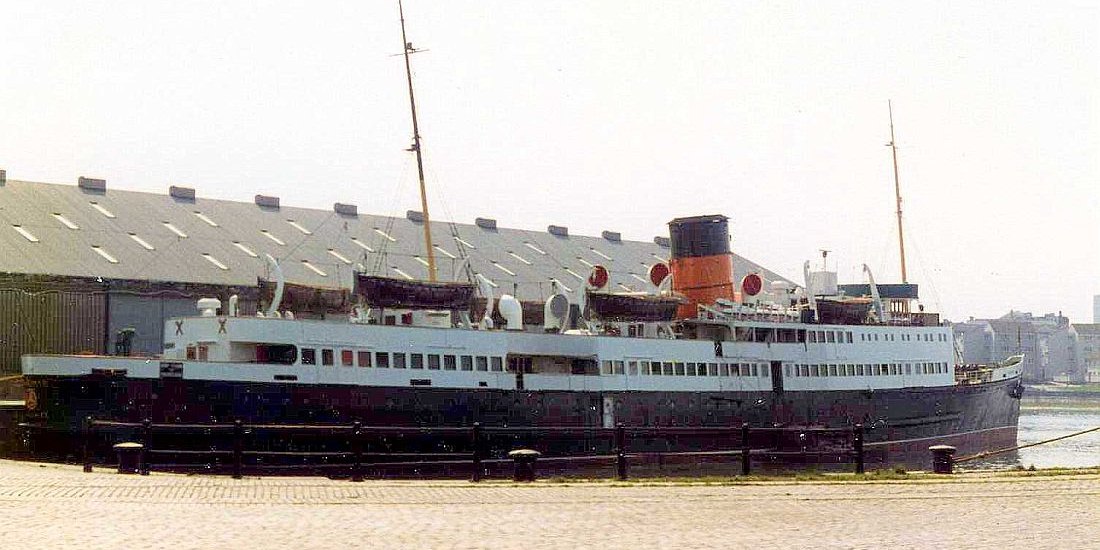
Above : Manxman - as she was whilst in service with the Isle of Man Steam Packet Company. Photo by Kenny Whyte
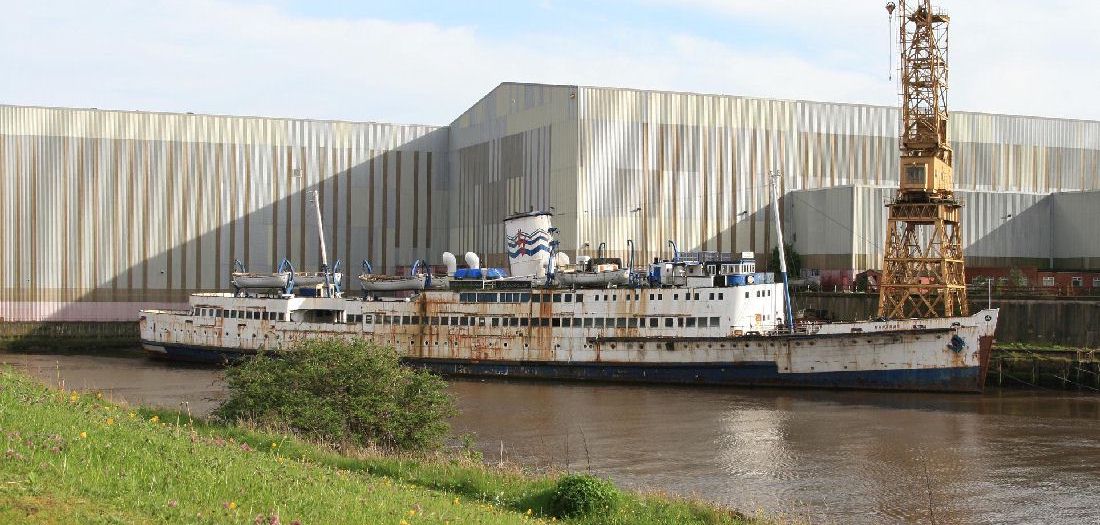
Above : At Pallion Engineering, Sunderland (K Whyte)
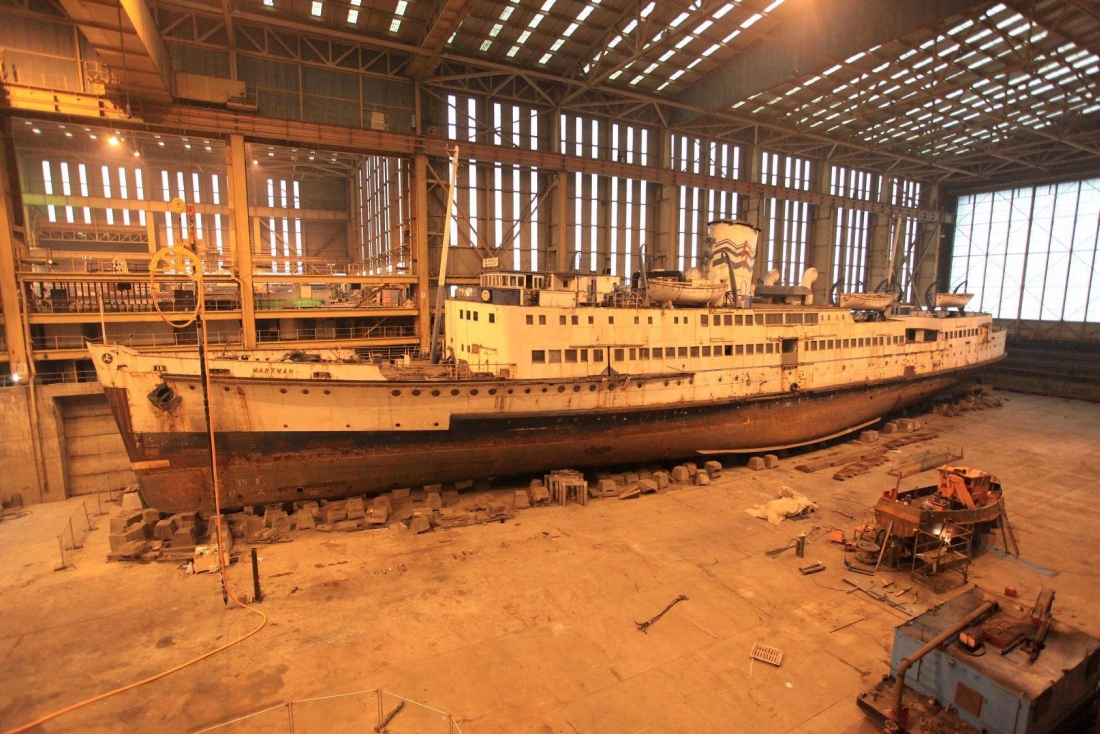

Above : July 2012 : Pallion Engineering, Sunderland. The end for TS Manxman (which served the Isle of Man 1955-1982), the last surviving short sea passenger turbine steamer which had been at Sunderland since 1997 after several failed preservation attempts. (K Whyte)
TUXEDO ROYALE (ex DOVER) : THE LAST SURVIVING FORMER CHANNEL AND IRISH SEA CAR FERRY
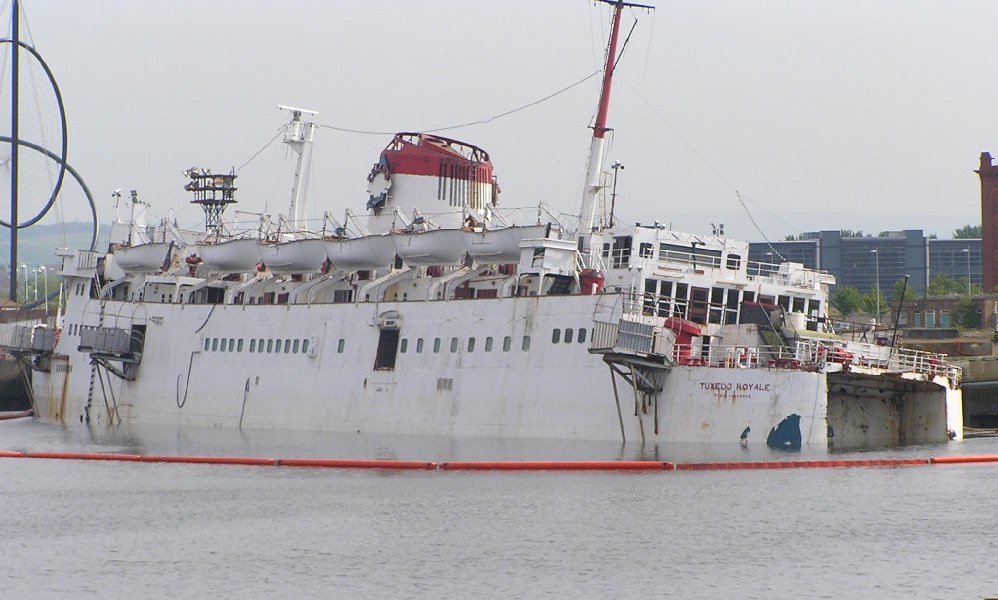
The former night-club ship Tuxedo Royale sank at her moorings close to the Transporter Bridge in Middlesbrough in early May 2011. Launched in 1965 at the Swan Hunter yard at Wallsend, SS Dover was the last turbine powered ship ordered for British Rail's Sealink service. In 1977 she became Earl Siward and in 1982 was again renamed, this time to Sol Express as she took up service in Greece. As Tuxedo Royale from 1993, she operated statically, latterly from Middlesbrough's Middlehaven dock. After closure following the liquidation of Absolute Leisure and the planned redevelopement of the dock, she was sent to Able UK's Graythorp Dock for scrapping, but was repreieved as the dock hosted the French aircraft carrier Clemenceau alongside a number of equally controversial paid-off ships from the US navy, all known to have toxic materials aboard. Tuxedo Royale was towed back to Able UK's quay at Middlesbrough and laid-up. She now floods to above car deck level with the tide and has been stripped of much valuable metal by local thieves, thought to be the cause of her to sink in the first place. Prior to the sinking, a group were looking to raise money to take the ship from the receivers and eventually return her to Dover and later, another group planning to save her locally. Recent events, including a fire aboard, have made this ambition even more problematic.
With nobody taking responsibility, it was decided by Middlesbrough Council, in ccoperation with Able UK, in late 2017 that the ship would be scrapped in situ
Return to